DoD DNA Lab Helps to Resolve Old Russian Mystery
Department Of Defense (DoD) Lab Helps to Resolve Century-Old Russian Mystery
Washington, July 15, 2008 - A Defense Department DNA identification lab has helped bring to a close a near-century-old mystery, laying to rest a search for the remains of two children executed alongside the rest of the family of Russia's last czar.
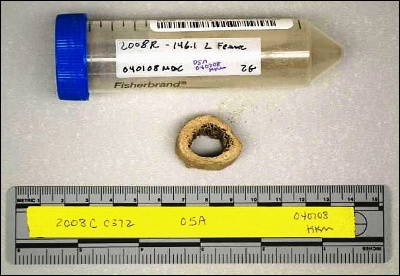
This male leg bone sample
found in a small grave in Russia positively identified the
remains there as the only son of the last czar of Russia,
eliminating rumors that some escaped the family's execution
in 1918.
In the midst of the Bolshevik Revolution in 1918, the imprisoned Nicholas II, his wife and five children were shot and killed along with four loyal servants in the basement of a merchant's house. The ruling Bolshevik party eventually would become the communist party of the Soviet Union.
What happened to the bodies remained somewhat of a mystery for years. Rumors circulated of survivors of the execution. Hundreds came forward over time claiming to be a surviving member of the royal family. The most prominent was Anna Anderson in 1920, who claimed to be the czar's youngest daughter, Anastasia.
More than a decade ago, the Russian government asked the Armed Forces DNA Identification Lab in Rockville, Md., to use its cutting-edge technology in DNA testing to help confirm the identify the royal family's remains after a mass grave was discovered. The lab positively identified the remains of the czar, his wife and three daughters, and later disproved Anderson's claims of royal heritage.
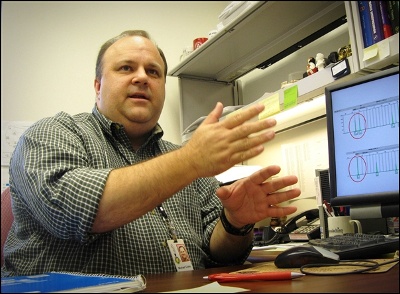
Dr. Michael Coble, the
research section chief for the Armed Forces DNA
Identification Laboratory, talks about the DNA testing of
bone samples from the missing two children of the last czar
of Russia. The czar and his family were executed in 1918
during a revolution. Defense Dept. photo by Fred W. Baker
III
That "put the lab on the map" in terms of leading the field in such testing, said Army Lt. Col. Louis N. Finelli, chief deputy medical examiner and director of the DoD DNA registry.
"That's our index case. It launched us from a fledgling mitochondrial DNA laboratory to one of the premier laboratories," Finelli said.
But the remains of two children, a boy and a girl, were still missing, opening the door for some to speculate that maybe there were survivors of the execution.
Now, the lab has again helped the Russian government by identifying the remains of those two children, found last year in a shallow grave about 70 feet from the larger gravesite.
"There's no doubt that nobody escaped," said Dr. Michael Coble, the research section chief for the lab. "We can conclude here that based on this evidence, we have [recovered] the two missing children."
Originally, according to historical accounts, the bodies of the family were thrown down a mine shaft in the town of Yekaterinburg, where they where killed. But Bolshevik leaders feared that a counterrevolutionary movement would recover the bodies.
According to accounts, a truck that was moving the remains to another location broke down en route, about 12 miles north of Yekaterinburg. It was decided to destroy the remains there.
Wanting to ensure the bodies were not recovered, the Bolsheviks first tried to destroy the remains of two of the children. They chopped up the bodies, set them on fire, and poured sulfuric acid on them.
"They tried everything they could to completely dissolve the remains, and it didn't work," Coble said.
Because the exhaustive efforts did not yield the expected results, it was decided to bury the remaining bodies in another mass grave nearby. The bodies were doused with sulfuric acid and covered with dirt.
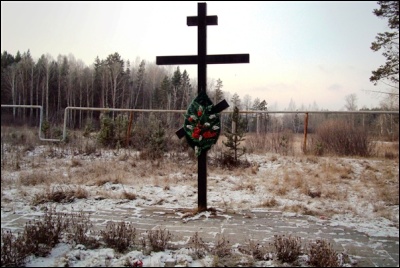
A memorial stands at the
gravesite of the last czar of Russia, his wife, and three of
his children. Executed together in 1918, the family was
buried in separate graves. For years, there have been rumors
of survivors of the execution. The Armed Forces DNA
Identification Laboratory has helped end the mystery by
identifying the remains of the czar and his entire family.
Courtesy photo by Dr. Michael Coble, Armed Forces DNA
Identification Laboratory
The larger grave was discovered in the 1970s, Coble said, but the remains weren't recovered until 1991, after communism fell in the country.
The smaller grave was discovered last summer. At the site were telltale remains of bones, bullets and ceramic pieces of the containers that held sulfuric acid. Time and torture had taken their toll on the remains, though. Only 44 bone fragments remained in the grave, most so small they weren't useful for DNA testing.
The Russian government contacted the DoD lab in October and asked them to help with the DNA identification. The lab is one of the oldest and largest labs working with "ancient" DNA testing, or testing from severely degraded samples, Coble said. The lab is used routinely to identify the remains of missing U.S. servicemembers not identifiable by means other than DNA testing.
Most commercial labs test DNA collected from hair samples, but the DoD lab works with more bone samples than any other lab in the country -- as many as 800 samples a year.
"We have one of the world's greatest labs as far as doing these types of investigations," Coble said.
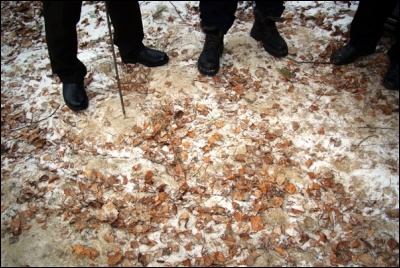
Researchers and scientists
stand at the gravesite of the missing two children of the
last czar of Russia. The site was discovered in 2007, and
the Armed Forces DNA Identification Laboratory helped the
Russian government identify the remains of the two children.
Courtesy photo by Dr. Michael Coble, Armed Forces DNA
Identification Laboratory
The lab worked in conjunction with the Institute for Forensic Medicine in Innsbruck, Austria, and with a Russian scientist doing collaborative work at a lab at the University of Massachusetts.
Multiple labs testing the same remains and drawing the same conclusions ensures that the results are reliable and none of the evidence was contaminated, Coble said.
A handful of scientists and technicians at the DoD lab spent about a month's worth of man-hours on the project. Tests from fresh DNA samples can be turned around in a day, but with these cases, the analysis can take much longer.
The lab received 10 samples, most in poor condition. Some were thin skull fragments. By the time they were sanded, scrubbed and cleaned up, there was little left for testing; some were only the size of a dime.
Two main fragments, though, were about a half inch thick and a couple of inches in diameter. They were thigh bones, hollow in the middle, one from a male and one from a female. Leg bone samples are best for DNA testing, Coble said, because they are thick and dense.
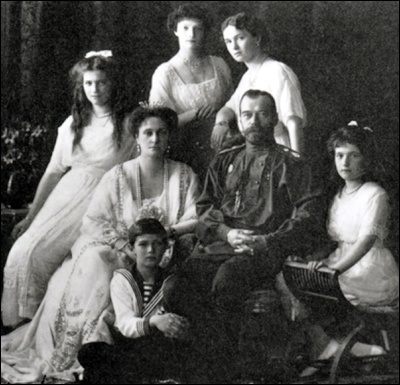
Czar Nicholas II of Russia
pictured with this family.
Mark Wadhams, assistant technical leader for the mitochondrial DNA section, worked on the case. He said that once the bones are cleaned, they are ground into a fine powder, about the consistency of fine sand, and an "extraction" buffer is added. The extraction buffer dissolves the bone powder into liquid and allows the release of the biological material.
Scientists then remove the DNA from the liquid, to get the DNA extract. The sample is reduced from about 3 milliliters of volume to about 200 microliters of clear liquid in a tube.
The biggest potential contaminate to the samples is the lab workers themselves.
"Since your body sloughs off probably over 400,000 cells per day, you have a potential to get into that sample pretty easily," Wadhams said.
The amount of DNA collected depends on the quality of the sample. From the nearly 100-year-old samples, not a lot was expected, Wadhams said.
"The samples were much smaller and much more degraded. You never know by looking at a sample whether it's going to work or not, so you basically have to go through the entire process to see if it will work," Wadhams said.
The DoD lab scientists tested the remains three ways.
First they tested its mitochondrial DNA, which is passed from the mother to her children. Using this testing, they established that both remains had the same mitochondrial sequence as that recovered earlier from the czar's wife's remains.
The lab scientists now knew, based on the initial DNA testing on the remains of the mother and children in the larger grave, that they had strong evidence that these were the remains of the two missing siblings.
But mitochondrial DNA is not unique to an individual, in that the testing proves only relationship, not necessarily identity.
So the lab then looked at the nuclear DNA of the samples. Everyone gets half of their nuclear DNA from each parent. This data showed that the samples were from a male and female who shared some DNA.
In fact, the data showed that it was more than 5 million times more likely they were related to each other than not, Coble said. Scientists are typically convinced of relationship with a likelihood ratio greater than 500, he said.
Then, to prove that the remains were the missing siblings of the Russian royal family, the lab went back to samples from the larger gravesite and developed DNA profiles of the other siblings and parents.
When the samples were matched, the data showed that the likelihood they were members of the royal family was more than 4 trillion times the likelihood they were not. A typically strong likelihood ratio would be more than 1,000, Coble said.
Finally, the lab tested the Y chromosome of the male sample. That test again confirmed that the remains of the male child indeed were those of the czar's only son.
"We have very strong evidence on all three marker systems that what have here are the [remains of the] missing children," Coble said.
The lab delivered a preliminary report to the Russian government about a month ago, detailing the findings of the lab. The results were officially released today.
Finelli said this type of cooperation between the two governments "transcends the politics of what may be the relationship between the two countries." And, he added, the lessons learned from these types of cases are applied to the daily mission of the lab.
"These types of cases are so challenging that we can apply what we learn in those cases to the current-day effort of [the servicemember identification] mission," Finelli said. "We test ourselves with these very hard cases, and then we can apply it to the casework to account for our fallen. So it's always a little bit of a selfish motivation."
-- By Fred W. Baker III, American Forces Press Service
ENDS
Latest World News | Top World News | World Digest | Archives | RSS


 International AIDS Society: IAS Announces Rio De Janeiro As Host City For AIDS 2026
International AIDS Society: IAS Announces Rio De Janeiro As Host City For AIDS 2026 Our Schools: Trump And Republicans Want Taxpayers To Fund Their Pet Project - Private Schools
Our Schools: Trump And Republicans Want Taxpayers To Fund Their Pet Project - Private Schools Science Media Centre: Dengue In The Pacific Region – Expert Q&A
Science Media Centre: Dengue In The Pacific Region – Expert Q&A New Zealand Defence Force: NZDF Prepares For Major Warfighting Exercise In Australia
New Zealand Defence Force: NZDF Prepares For Major Warfighting Exercise In Australia Greenpeace: Dairy Industry Greenwashing Under Fire As Lawsuits Go Global
Greenpeace: Dairy Industry Greenwashing Under Fire As Lawsuits Go Global Greenpeace: French Authorities Block Greenpeace Ship From Participating In UN Ocean Conference
Greenpeace: French Authorities Block Greenpeace Ship From Participating In UN Ocean Conference